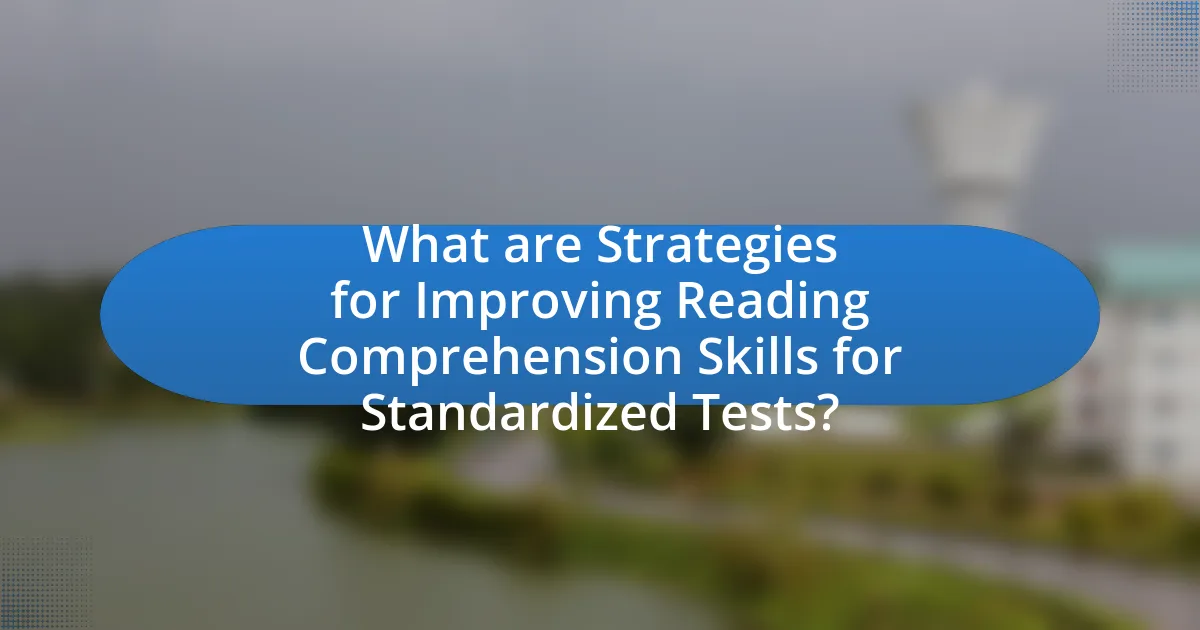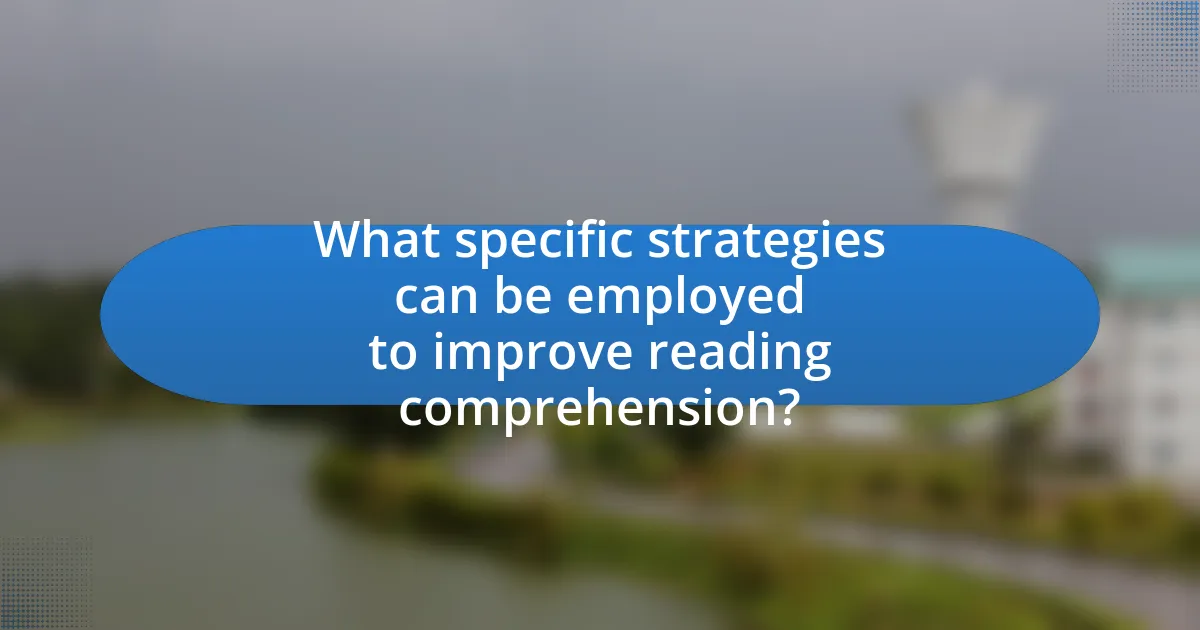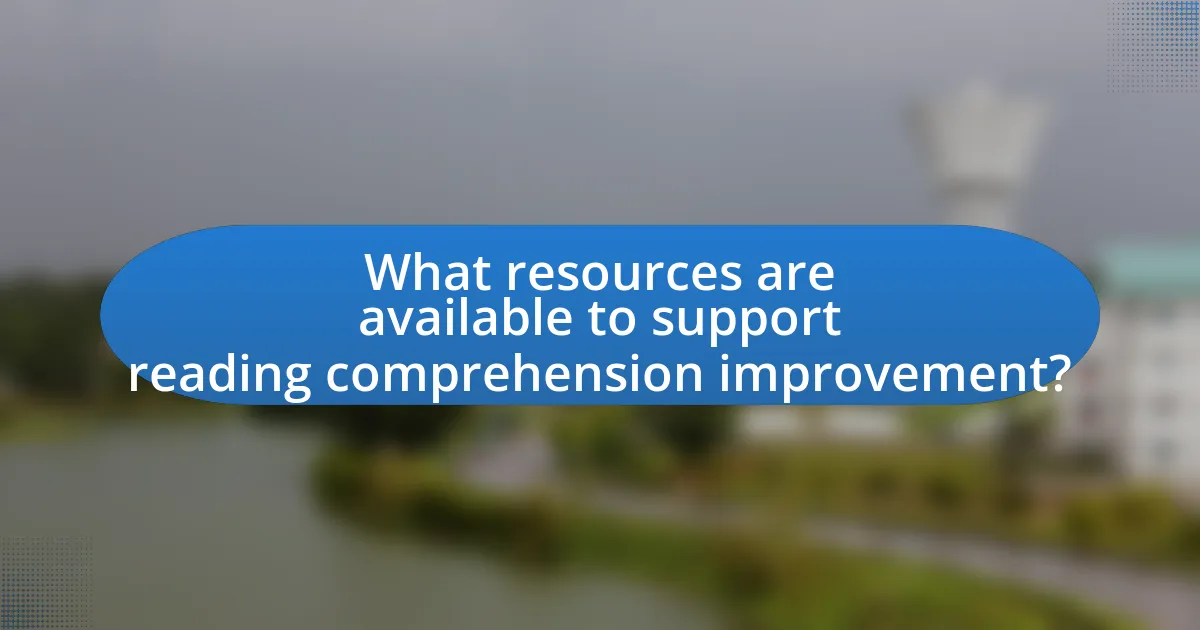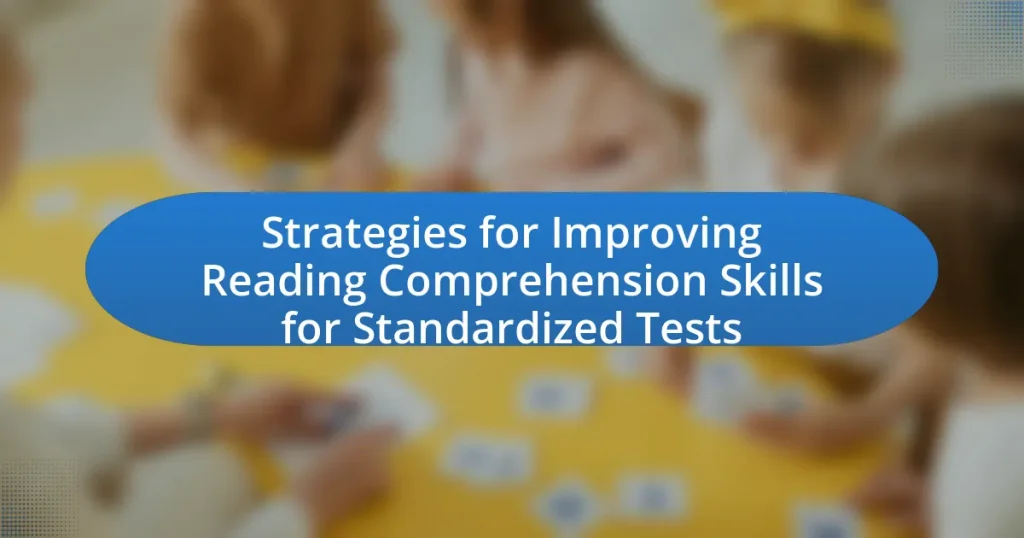The article focuses on strategies for improving reading comprehension skills specifically for standardized tests. It outlines various techniques such as active reading, summarization, questioning, and visualization, which enhance understanding and retention of complex texts. The importance of reading comprehension is emphasized, highlighting its direct impact on test performance and overall academic success. Additionally, the article addresses common challenges students face, the role of distractions, and misconceptions that hinder progress, while providing resources and best practices for both students and educators to support skill development.

What are Strategies for Improving Reading Comprehension Skills for Standardized Tests?
Strategies for improving reading comprehension skills for standardized tests include active reading techniques, summarization, and practice with diverse texts. Active reading involves engaging with the material by highlighting key points and taking notes, which enhances retention and understanding. Summarization requires distilling information into concise summaries, reinforcing comprehension and recall. Additionally, practicing with a variety of texts, including fiction, non-fiction, and academic articles, exposes students to different writing styles and vocabulary, improving adaptability in comprehension. Research indicates that these strategies can lead to significant improvements in test performance, as they promote critical thinking and analytical skills essential for understanding complex texts.
Why is reading comprehension important for standardized tests?
Reading comprehension is crucial for standardized tests because it directly impacts a student’s ability to understand and analyze test questions and passages. High reading comprehension skills enable students to extract key information, make inferences, and draw conclusions, which are essential for answering questions accurately. Research indicates that students with strong reading comprehension skills tend to perform better on standardized assessments, as they can navigate complex texts and comprehend nuanced meanings, leading to higher scores. For instance, the National Assessment of Educational Progress (NAEP) consistently shows a correlation between reading proficiency and overall academic performance in standardized testing contexts.
How does reading comprehension impact test scores?
Reading comprehension significantly impacts test scores by determining a student’s ability to understand and analyze questions and passages effectively. High reading comprehension skills enable students to grasp complex concepts, follow instructions accurately, and extract relevant information from texts, which are essential for answering test questions correctly. Research indicates that students with strong reading comprehension skills tend to score higher on standardized tests; for instance, a study published in the Journal of Educational Psychology found that reading comprehension was a strong predictor of performance on both reading and math assessments, highlighting its critical role in overall academic success.
What role does reading comprehension play in overall academic success?
Reading comprehension is crucial for overall academic success as it directly impacts a student’s ability to understand and engage with educational material across subjects. Proficient reading comprehension enables students to grasp complex concepts, follow instructions, and analyze information critically, which are essential skills for academic achievement. Research indicates that students with strong reading comprehension skills tend to perform better on standardized tests, as they can interpret questions accurately and apply their knowledge effectively. For instance, a study by the National Assessment of Educational Progress found that students who excel in reading comprehension score significantly higher in mathematics and science assessments, demonstrating the interconnectedness of reading skills and academic performance.
What are the key components of effective reading comprehension strategies?
Effective reading comprehension strategies include active engagement, summarization, questioning, and visualization. Active engagement involves interacting with the text through annotations or discussions, which enhances understanding. Summarization requires distilling the main ideas and supporting details, aiding retention and clarity. Questioning encourages readers to think critically about the material, fostering deeper insights. Visualization helps in creating mental images of the content, making it easier to recall information. Research indicates that these strategies significantly improve comprehension skills, as evidenced by studies showing that students who employ these techniques perform better on standardized tests.
What techniques can enhance understanding of complex texts?
Techniques that can enhance understanding of complex texts include active reading, summarization, and annotation. Active reading involves engaging with the text through questioning and predicting, which helps to clarify meaning and retain information. Summarization requires distilling the main ideas and supporting details, allowing readers to grasp the core message more effectively. Annotation, or making notes in the margins, facilitates deeper interaction with the text, enabling readers to highlight key concepts and clarify confusing sections. Research indicates that these strategies significantly improve comprehension skills, as evidenced by studies showing that students who employ active reading techniques score higher on reading assessments compared to those who do not.
How can summarization improve comprehension skills?
Summarization enhances comprehension skills by requiring individuals to distill information into essential points, thereby reinforcing understanding and retention. This process engages critical thinking, as it compels readers to identify main ideas and supporting details, which are crucial for grasping complex texts. Research indicates that students who practice summarization demonstrate improved reading comprehension scores, as evidenced by a study published in the Journal of Educational Psychology, which found that summarization techniques led to a 20% increase in comprehension test scores among participants.
What common challenges do students face in reading comprehension?
Students commonly face challenges in reading comprehension such as difficulty in identifying main ideas, lack of vocabulary knowledge, and problems with making inferences. These challenges hinder their ability to understand and analyze texts effectively. For instance, research indicates that students often struggle to extract central themes from passages, which is crucial for answering comprehension questions accurately. Additionally, limited vocabulary can impede their understanding of complex texts, as unfamiliar words may lead to misinterpretation. Furthermore, the inability to make inferences based on context can result in a superficial understanding of the material, affecting overall performance in standardized tests.
How do distractions affect reading comprehension during tests?
Distractions significantly impair reading comprehension during tests by disrupting focus and cognitive processing. When individuals encounter distractions, such as noise or visual interruptions, their ability to concentrate on the text diminishes, leading to decreased understanding and retention of information. Research indicates that even brief distractions can result in lower test scores, as they hinder the brain’s capacity to integrate and analyze the material effectively. For instance, a study published in the Journal of Educational Psychology found that students exposed to background noise scored 20% lower on reading comprehension tests compared to those in a quiet environment. This evidence underscores the critical impact of distractions on reading comprehension during testing scenarios.
What misconceptions about reading comprehension hinder progress?
Misconceptions about reading comprehension that hinder progress include the belief that comprehension is solely about decoding words and that it does not require active engagement with the text. This misunderstanding leads to a focus on surface-level reading rather than deeper analysis and critical thinking. Research indicates that effective comprehension involves integrating prior knowledge with new information, as highlighted in the study “The Role of Prior Knowledge in Reading Comprehension” by McNamara and Magliano, which emphasizes that readers who actively connect their knowledge to the text perform better on comprehension tasks. Additionally, the misconception that comprehension can be improved solely through practice without strategy instruction limits learners’ ability to develop essential skills such as summarization and inference-making.
How can students assess their reading comprehension skills?
Students can assess their reading comprehension skills by utilizing practice tests and comprehension quizzes that measure their understanding of texts. These assessments often include multiple-choice questions, short answer questions, and summarization tasks that require students to demonstrate their grasp of main ideas, details, and inferences from the reading material. Research indicates that regular practice with these types of assessments can lead to improved performance on standardized tests, as they help identify specific areas where comprehension may be lacking, allowing for targeted improvement strategies.
What tools are available for measuring reading comprehension?
Tools available for measuring reading comprehension include standardized assessments, informal reading inventories, and comprehension tests. Standardized assessments, such as the SAT and ACT, evaluate reading comprehension through multiple-choice questions based on passages. Informal reading inventories, like the Qualitative Reading Inventory, provide a more personalized assessment by analyzing a student’s reading level and comprehension through one-on-one interactions. Comprehension tests, such as the Gray Oral Reading Tests, measure a student’s ability to understand and interpret text. These tools are widely used in educational settings to gauge reading comprehension skills effectively.
How can self-assessment improve reading strategies?
Self-assessment can significantly improve reading strategies by enabling individuals to identify their strengths and weaknesses in comprehension. When readers evaluate their understanding of texts, they can pinpoint specific areas that require more focus, such as vocabulary, inference skills, or summarization techniques. Research indicates that self-assessment fosters metacognitive awareness, allowing readers to adjust their strategies based on their performance. For instance, a study published in the Journal of Educational Psychology found that students who engaged in self-assessment demonstrated enhanced reading comprehension scores on standardized tests, as they were better equipped to apply targeted strategies to their reading practices.

What specific strategies can be employed to improve reading comprehension?
To improve reading comprehension, specific strategies include active reading, summarization, questioning, and visualization. Active reading involves engaging with the text through annotations and highlighting key points, which enhances retention and understanding. Summarization requires readers to distill the main ideas and supporting details into concise statements, reinforcing comprehension. Questioning encourages readers to ask themselves about the content, fostering deeper engagement and critical thinking. Visualization involves creating mental images of the text, which aids in memory and understanding. Research indicates that these strategies can significantly enhance comprehension skills, particularly in the context of standardized tests, where understanding complex texts is crucial for success.
How can active reading techniques enhance comprehension?
Active reading techniques enhance comprehension by promoting engagement with the text, which leads to better retention and understanding of the material. Techniques such as annotating, summarizing, and questioning encourage readers to interact with the content, facilitating deeper cognitive processing. Research indicates that students who employ active reading strategies score higher on comprehension assessments, as these methods help to clarify complex ideas and improve recall. For instance, a study published in the Journal of Educational Psychology found that students who used annotation while reading demonstrated a 25% increase in comprehension scores compared to those who read passively.
What is the role of annotation in active reading?
The role of annotation in active reading is to enhance comprehension and retention of the material. By marking important points, summarizing sections, and posing questions in the margins, readers engage more deeply with the text. This active engagement has been shown to improve understanding, as evidenced by research indicating that students who annotate while reading perform better on comprehension tests compared to those who do not annotate.
How can questioning the text improve engagement and understanding?
Questioning the text enhances engagement and understanding by prompting readers to actively interact with the material. This active engagement encourages deeper cognitive processing, leading to better retention and comprehension of the content. Research indicates that when readers formulate questions about the text, they are more likely to identify key concepts and make connections between ideas, which facilitates a more profound understanding. For instance, a study published in the Journal of Educational Psychology found that students who engaged in self-questioning while reading demonstrated significantly higher comprehension scores compared to those who did not. This evidence supports the notion that questioning serves as a critical strategy in improving reading comprehension skills, particularly in the context of standardized tests.
What are some effective pre-reading strategies?
Effective pre-reading strategies include previewing the text, activating prior knowledge, and setting a purpose for reading. Previewing involves skimming headings, subheadings, and any visuals to gain an overview of the content, which helps in anticipating the material. Activating prior knowledge means recalling what is already known about the topic, which enhances understanding and retention. Setting a purpose for reading involves determining specific goals, such as identifying key themes or answering particular questions, which directs focus and improves comprehension. Research indicates that these strategies can significantly enhance reading comprehension, particularly in standardized test contexts, as they prepare the reader to engage more effectively with the material.
How does previewing the text aid in comprehension?
Previewing the text aids in comprehension by allowing readers to identify key concepts and the overall structure before engaging with the material. This initial overview helps to activate prior knowledge and set a purpose for reading, which enhances focus and retention of information. Research indicates that students who preview texts demonstrate improved understanding and recall, as they can better connect new information to existing knowledge frameworks. For instance, a study published in the Journal of Educational Psychology found that students who previewed reading materials scored significantly higher on comprehension tests compared to those who did not.
What is the importance of setting a purpose for reading?
Setting a purpose for reading is crucial as it enhances comprehension and retention of information. When readers establish a clear objective, such as understanding a concept or preparing for a test, they engage more actively with the text, leading to better focus and critical thinking. Research indicates that purposeful reading strategies can improve performance on standardized tests, as they help readers identify key ideas and relevant details more effectively. For instance, a study published in the “Journal of Educational Psychology” by Pressley and Afflerbach (1995) highlights that students who set specific goals for their reading tasks demonstrate higher levels of comprehension and recall.
How can post-reading strategies reinforce comprehension?
Post-reading strategies reinforce comprehension by encouraging reflection and analysis of the text. These strategies, such as summarization, questioning, and discussion, help readers consolidate their understanding and identify key concepts. Research indicates that engaging in post-reading activities can enhance retention and comprehension, as evidenced by a study published in the Journal of Educational Psychology, which found that students who utilized summarization techniques scored significantly higher on comprehension tests compared to those who did not. This demonstrates that post-reading strategies are effective tools for improving reading comprehension skills, particularly in the context of standardized tests.
What methods can be used for effective summarization after reading?
Effective summarization after reading can be achieved through methods such as the Cornell Note-taking System, mind mapping, and the use of summarization frameworks like the 5 W’s (Who, What, When, Where, Why). The Cornell Note-taking System encourages organized notes that facilitate review and synthesis of key concepts, while mind mapping visually represents relationships between ideas, enhancing recall. The 5 W’s framework helps distill essential information by focusing on critical elements of the text. Research indicates that these methods improve retention and understanding, making them valuable for standardized test preparation.
How can discussion and collaboration enhance understanding of the text?
Discussion and collaboration enhance understanding of the text by allowing individuals to share diverse perspectives and clarify complex ideas. Engaging in dialogue encourages deeper analysis, as participants articulate their interpretations and challenge each other’s viewpoints. Research indicates that collaborative learning environments improve comprehension; for instance, a study by Johnson and Johnson (1999) found that cooperative learning strategies significantly boost academic achievement and critical thinking skills. This interaction not only solidifies individual understanding but also fosters a collective knowledge base, making the text more accessible and meaningful to all participants.

What resources are available to support reading comprehension improvement?
Resources available to support reading comprehension improvement include educational websites, instructional books, and interactive software. Websites like ReadTheory and Newsela provide leveled reading materials and comprehension quizzes tailored to various skill levels. Instructional books such as “The Reading Strategies Book” by Jennifer Serravallo offer practical strategies and activities for educators and learners. Additionally, interactive software like Raz-Kids and IXL Reading provides personalized reading practice and feedback, enhancing comprehension skills through engaging formats. These resources are widely recognized for their effectiveness in improving reading comprehension among students preparing for standardized tests.
What types of reading materials can aid in skill development?
Reading materials that can aid in skill development include textbooks, academic journals, instructional manuals, and practice workbooks. Textbooks provide foundational knowledge and structured learning, while academic journals offer insights into current research and advanced concepts. Instructional manuals enhance practical skills through step-by-step guidance, and practice workbooks allow for hands-on application of learned skills. Research indicates that engaging with diverse reading materials improves comprehension and retention, which is essential for success in standardized tests.
How do practice tests contribute to improving reading comprehension?
Practice tests enhance reading comprehension by providing targeted practice that familiarizes individuals with the format and types of questions they will encounter. This exposure helps to develop critical reading skills, such as identifying main ideas, understanding context, and making inferences. Research indicates that repeated exposure to test formats through practice tests can lead to improved performance; for instance, a study published in the Journal of Educational Psychology found that students who engaged in practice testing scored significantly higher on reading comprehension assessments compared to those who did not. This improvement is attributed to the reinforcement of comprehension strategies and the reduction of test anxiety, allowing for better focus and retention of information.
What role do educational apps and websites play in skill enhancement?
Educational apps and websites significantly enhance skills by providing interactive and personalized learning experiences. These platforms often utilize adaptive learning technologies that tailor content to individual user needs, thereby improving engagement and retention. For instance, a study published in the Journal of Educational Psychology found that students using educational apps showed a 30% increase in reading comprehension scores compared to traditional methods. This demonstrates that the integration of technology in education can lead to measurable improvements in skill acquisition.
How can teachers and parents support reading comprehension development?
Teachers and parents can support reading comprehension development by engaging students in discussions about the texts they read. This interaction helps students articulate their understanding and encourages critical thinking. Research indicates that when parents ask open-ended questions about a story, it enhances children’s ability to make inferences and draw conclusions, which are essential skills for comprehension. Additionally, teachers can implement strategies such as guided reading sessions and vocabulary instruction, which have been shown to improve comprehension skills significantly. For instance, a study published in the Journal of Educational Psychology found that explicit vocabulary instruction can lead to a 30% increase in reading comprehension scores among elementary students.
What strategies can parents use to encourage reading at home?
Parents can encourage reading at home by creating a dedicated reading space and establishing a daily reading routine. A designated area with comfortable seating and good lighting can make reading more inviting, while a consistent schedule helps children develop a habit. Research indicates that children who read regularly improve their comprehension skills, which is crucial for standardized tests. Additionally, parents can engage in discussions about the books, ask open-ended questions, and provide a variety of reading materials to cater to their child’s interests, further enhancing comprehension and critical thinking skills.
How can teachers create a supportive reading environment in the classroom?
Teachers can create a supportive reading environment in the classroom by incorporating diverse reading materials, fostering a culture of reading, and providing individualized support. By offering a variety of genres and formats, such as fiction, non-fiction, and digital texts, teachers can engage students with different interests and reading levels. Research indicates that exposure to diverse texts enhances students’ comprehension skills, as it allows them to make connections and develop critical thinking (Guthrie & Wigfield, 2000). Additionally, establishing a classroom culture that values reading, through activities like book clubs and reading challenges, encourages students to view reading as an enjoyable and essential part of learning. Providing individualized support, such as targeted reading interventions and one-on-one guidance, ensures that each student receives the help they need to improve their reading skills effectively.
What are some best practices for improving reading comprehension skills?
To improve reading comprehension skills, individuals should engage in active reading strategies such as annotating texts, summarizing passages, and asking questions about the material. Active reading enhances understanding by encouraging readers to interact with the content, which has been shown to increase retention and comprehension. Research indicates that students who annotate while reading demonstrate better recall and understanding of the material compared to those who do not. Additionally, practicing with diverse texts and taking timed reading exercises can help develop skills necessary for standardized tests, as these practices familiarize readers with different styles and formats, ultimately improving their ability to comprehend and analyze information effectively.
How can regular practice and exposure to diverse texts enhance skills?
Regular practice and exposure to diverse texts enhance skills by improving reading comprehension, vocabulary, and critical thinking abilities. Engaging with a variety of genres and styles exposes individuals to different writing techniques and perspectives, which fosters adaptability in understanding complex materials. Research indicates that students who read a wide range of texts demonstrate higher performance on standardized tests, as they develop a more robust vocabulary and better analytical skills. For instance, a study published in the Journal of Educational Psychology found that students who engaged with diverse reading materials scored significantly higher on comprehension assessments compared to those who read a limited selection. This evidence supports the notion that varied reading experiences are crucial for skill enhancement.
What tips can help students stay focused and engaged while reading?
To help students stay focused and engaged while reading, they should implement strategies such as setting specific reading goals, minimizing distractions, and taking regular breaks. Setting clear objectives, like reading a certain number of pages or chapters, provides direction and motivation. Minimizing distractions, such as turning off electronic devices and finding a quiet environment, enhances concentration. Taking regular breaks, such as the Pomodoro Technique, which involves reading for 25 minutes followed by a 5-minute break, helps maintain mental stamina and prevents fatigue. Research indicates that these strategies can significantly improve reading comprehension and retention, as they align with cognitive principles of attention and memory.

